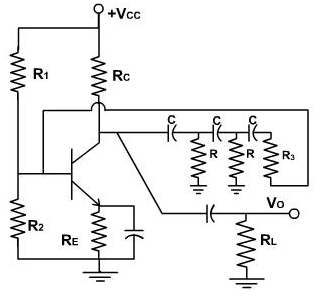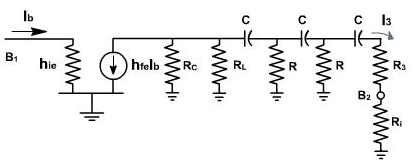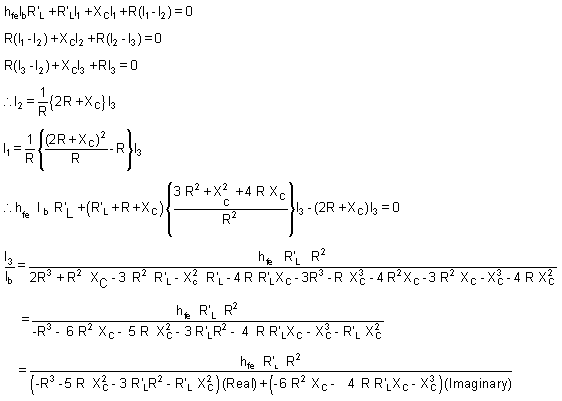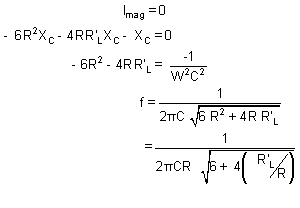Transistor Phase Shift Oscillator:
At the low frequencies (around 100 kHz or less), resistors and capacitors are usually employed to determine the frequency of oscillation. Figure 1 shows transistorized phase shift oscillator circuit employing RC network. If phase shift through the common emitter amplifier is 180°, then the oscillation may take place at the frequency where the RC network produces an additional phase shift of 180°.
Since the transistor is used as an active element, the output across R of feedback network is shunted by the relatively low input resistance of transistor, because input diode is a forward biased diode

Figure 1
Hence, instead of employing the voltage series feedback, voltage shunt feedback is used for the transistor phase shift oscillator. The load resistance RL is also connected by the coupling capacitor. The equivalent circuit using h-parameter is shown in the figure 2.

Figure 2
For the circuit, load resistance RL may be lumped with the RC and effective load resistance becomes R'L(= RC || RL). The 2 h-parameters of the CE transistor amplifier, hoe and hre can be neglected.
The capacitor C provides some impedance at frequency of oscillation and, thus, it is kept as it is, while coupling capacitor behaves like AC short. The input resistance of transistor is Ri≈hie. Thus the resistance R3 is selected so that R=R3+Ri=R3+hie. This choice makes 3 R C selections alike and simplifies calculation. The effect of biasing resistor R1, R2, & REon the circuit operation can be neglected.
As this is a voltage shunt feedback, hence instead of finding VR /VO, we should find current gain of the feedback loop.
The simplified equivalent circuit is shown in the figure 3.

Figure 3
Applying KVL,

Since I3 and Ib must be in phase to satisfy the Barkhausen criterion, hence

Initially I3 > Ib also, therefore, for the oscillation to start,

Therefore, the 2 conditions should be satisfied for the oscillation to begin and sustain.
Email based Electronics Devices and circuits assignment help - homework help at Expertsmind
Are you searching Electronics Engineering assignment help expert for help with Transistor Phase Shift Oscillator questions? Transistor Phase Shift Oscillator topic is not easier to learn without any external help? We at www.expertsmind.com offers free lecture notes for Electronics Devices and circuits assignment help and Electronics Devices and circuits homework help. Live tutors are available 24x7 hours for helping students in their Transistor Phase Shift Oscillator related problems. We provide step by step Transistor Phase Shift Oscillator question's answers with 100% plagiarism free content. We prepare quality content and notes for Transistor Phase Shift Oscillator topic under Electronics Devices and circuits theory and study material. These are avail for subscribed users and they can get advantages anytime.
Why Expertsmind for assignment help
- Higher degree holder and experienced experts network
- Punctuality and responsibility of work
- Quality solution with 100% plagiarism free answers
- Time on Delivery
- Privacy of information and details
- Excellence in solving electronics engineering questions in excels and word format.
- Best tutoring assistance 24x7 hours